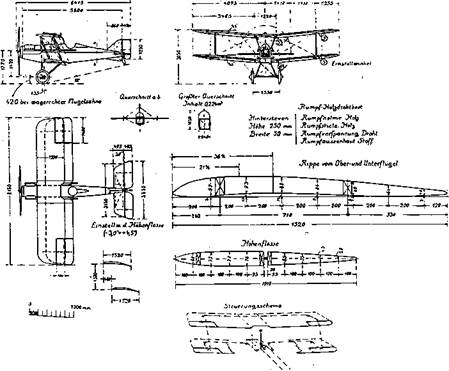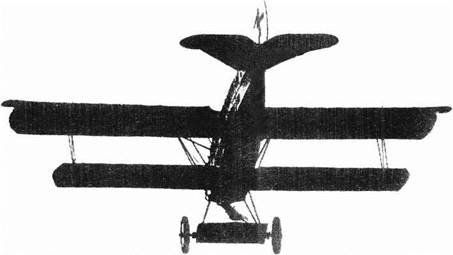Contrasting Design Philosophies
Comparison of the 1917 British (Royal Aircraft Factory) S.(scouting) E.(experimental)-5 and the Fokker D-VII shows an interesting contrast between the design philosophies of the Royal Aircraft Factory designers, who had been exposed to primitive airplane stability theory, and Anthony H. G. Fokker and his co-worker, Reinhold Platz, neither of whom had any formal technical training. Platz had been trained in the art of acetylene gas welding, which he applied to the construction of steel tube airplane fuselages, while Fokker was an experienced craftsman, pilot, and small boat sailor with an instinct for aerodynamics.
The strong dihedral (5 degrees) of the S. E.-5 wings (Figure 1.4) is evidence of an attempt to give the airplane inherent spiral stability. On spirally stable airplanes, if the pilot establishes a banked turn, the rudder and elevator have to be held in a deflected position to continue the turn. If the pilot centers the rudder bar and control stick, a correctly rigged airplane will automatically, but slowly, regain wings-level flight.
|
Figure 1.4 The British paid attention to inherent spiral stability during World War I days, building 5 degrees of dihedral into the S. E.-5. (From Jane’s All the World’s Aircraft, 1919. Jane’s used a German source for these drawings since the S. E.-5 was still classified in Britain in 1919.) |
The S. E.-5’s control surfaces had no aerodynamic balance and were difficult to move at diving speeds. Thin wing sections were used. The designers also had embraced a whim for numerology; the wings had 250 square feet of area and 5-foot chords; they were set at 5 degrees with respect to the thrust line, and so on.
Modern flight tests of World War I fighters (using the Shuttleworth Collection) give the S. E.-5A high ratings. Ronald Beaumont says this airplane was
perhaps the best handling fighter on either side, with excellent pitch and yaw control and inherent stability on both axes, and with light and responsive ailerons up to the quite high speed of 130 mph.
The Fokker D VII (Figure 1.5) had wooden-frame cantilever wings, almost without dihedral, with a thick airfoil section, an early result of Prandtl/Lanchester circulation theory. David Lednicer reported (2001) that the D VII wing airfoil was close to the Gottingen 418. The D VII had a steel-tube-welded fuselage and tail assembly. Horn balances (called elephant ears) were provided to lessen the pilot effort to deflect the ailerons, elevators, and rudder.
When Fokker flew the first version he realized he had created a dangerous airplane. Before the German Air Ministry officials could get a good look at it, he rebuilt it secretly in the hangar, moving the wings aft to make it less unstable, lengthening the fuselage, and modifying the vertical tail to incorporate a fixed fin. As a result of the D VII’s long tail moment arm; blunt-nosed, cambered airfoil sections; and mechanically limited up elevator
|
Figure 1.5 The Fokker D-VII, built without wing dihedral, showing no concern for spiral stability. This machine had horn aerodynamic balances at the tips of all control surfaces, to reduce control forces. (From Progress in Airplane Design Since 1903, NASA Publication L-9866, 1974.) |
deflection, stability and control at low speeds and climb rate were quite good. In its final form it pleased everyone so much that it was mentioned in the Treaty of Versailles as a military airplane that had to be surrendered to the Allied authorities, the only one so designated.















